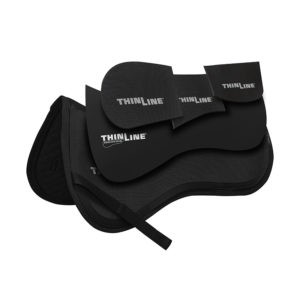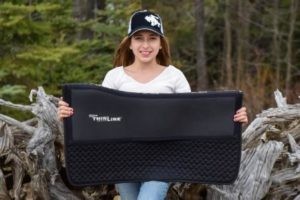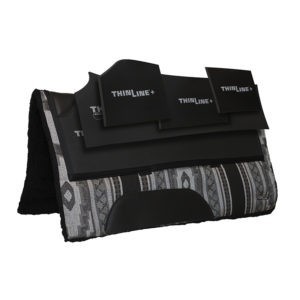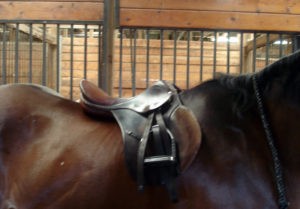Solve Bridging Issues – ThinLine Supports the Gap
If your saddle is bridging – it has little to no contact in the center – your best option will be to use a saddle pad that offers an open shimming system. While there are many corrective pads on the market, each horse, saddle and saddle pad combination are different, shimming in the right place is the most important starting point.
Shimming to create comfort for the swayback horse is not complicated but riders need to know what is important.
A swayback can cause soreness to a horse’s back because most saddles will “bridge,” putting the rider’s weight only on the front and the back of the saddle, creating abnormal pressure points, especially over the shoulders and loins. On the other hand, poor saddle fit can also contribute to swayback, as the horse will alter its stride and movement, including hollowing its back, and raising its head to avoid pain.
Top three things to know about saddles that bridge:
- The saddle pad should have an open pocket, allowing you to place the shim exactly where it is needed. Saddle-fitting pads with either closed-off pockets or bridging shims sewn into a pad can actually cause more damage if the placement of the shim and the thickness of the shim are either in the wrong place or too thick.
- The shims should be available in varying thicknesses and should have the ability to be stacked. If you correct the painful saddle fit your horse should begin creating a healthier top line. The goal is for you to reduce the number of shims as your horse gets stronger.
- Less is more. Start slowly. Use one set of shims, if the saddle is still bridging add a second set of shims and continue slowly. Over shimming will make the sway worse.
Bridging Shim Placement
When learning how to saddle a swayback horse with a corrective pad, it is important you are able to place a bridging shim in exactly the right place to provide even contact along the full panel of the saddle. Saddles will bridge in different areas depending upon your horses’ confirmation and the tree of the saddle. Once you have shimmed in the center, ride and check to see if you have an even sweat pattern along their top-line.
Sway Back Saddle Fitting Shims
Materials used to saddle a sway back horse are as important as the corrective pad itself. The materials need to be supportive, they need to provide pressure relief, they should not shift and they should be comfortable for your horse. By making our shims from the same material as our shock-absorbing saddle pads we can double the comfort for the horse while also creating perfect saddle fit. In addition to placement, the thickness of the bridging shim needs to be correct if you want your horse to lift their back and create a stronger top-line. We offer bridging shims in two thicknesses, allowing you to provide your horse with precisely the right amount of build-up.
Is it My Horse or My Saddle?
It could be either, or both. But don’t worry. We have spent two decades working with saddle fitters to give you all the options you need for a perfect and comfortable fit. We have a money-back guarantee so feel free to order shims and return those you do not need.
What is ThinLine?
ThinLine is a thin, supporting, shock-absorbing, nonslip, breathable foam.
Where is the ThinLine?
It is sewn onto the panel of our saddle pads.
Here you can see the ThinLine foam on top of a western cotton liner pad and the images of the shimming options on-top of an english half pad.
How Can You Fit A Saddle On A Swaybacked Horse? Often, simply using a ThinLine pad will correct minor bridging issues.
If you need more, easily fill in hollow areas with ThinLine saddle fit inserts.
Every pad comes with a layer of ThinLine foam.
Simply add ThinLine shims to solve more prominent saddle fitting and confirmation issues.
Quick Chart of Saddle Fit Issues and Solutions
- Hollow or Sway Backs: Add bridging shims.
- High Withers: Add Front shims to any pad.
- Rider Balance: Adding a pair of shims to one side can fix balance issues.
- Balance the saddle: Front or rear Shims, depending on your issue.
- Slippage: Generally no shims are needed, the ThinLine Pad alone will solve this.
- Saddle Pad Slippage: Generally your tree is too wide. Add a Full Shim.
- Equine or Rider Back Soreness: No shims needed, ThinLine protects both.
- Equine Asymmetry: place both of the pair of shims on the hollow side.
- Kissing Spine Relief: Add a Full Shim to any ThinLine pad.
- Treeless Saddle Pad Comfort: Add a Full Shim to any ThinLine Pad.
Shims can be found under each ThinLine Pad in our shop
Solutions for Saddles which Bridge or Horses with a Sway Back.
Is this a permanent solution? It is not uncommon to see swaybacked horses develop more topline in a ThinLine. Historically, riders eventually remove the bridging shim. To retain the good muscle on the top line you’ve developed continue using your ThinLine without the shims.
Stacking and Layering Saddle Fitting Shims
- ThinLine pads accept up to three 1/4 inch saddle fit shims in a single location.
- Layering sets of shims will create an even transition for major saddle fit issues. Shims may also be cut with a pair of scissors for custom work.
How to Order Saddle Fitting Shims
Select a ThinLine Saddle Pad. Below each pad, you will find a list of shims to add to your cart.
Saddle fitting with this with shock-absorbing foam provides comfort and protection for horse and rider. Now you simply need to find the pad that fits the dimensions of your saddle and the style that fits your lifestyle.
Read on if you need more detailed saddle fitting information on How Can You Fit A Saddle On A Swaybacked Horse?
Bridging Saddle Fit Issues

- Versatile Shims fill in hollow areas
- Top shock-absorbing materials protect backs
- Open pocket allows the rider to create a custom fit
- Renewed saddle balance enlivens confidence
- Equine and rider back soreness reduced or eliminated
- Asymmetry issues solved
- Kissing Spine relief
Signs of Poor Saddle Fit on Swayback Horse:
- Saddle Sores: caused by friction (movement of the saddle) or pressure. Girth and/or saddle are too tight or too loose and begin to rub the horse. Friction can also be caused by an imbalanced rider or incorrect saddle placement.
- White Hairs: are caused by too much pressure in a small spot. The pressure stops blood flow, kills the sweat gland and causes hair to turn white.
- Dry Spots: after you ride the horses back should be evenly wet where the saddle lies. Dry spots suggest there is either too much pressure or not enough contact in one spot.
- Muscle Atrophy: your saddle is probably pinching the horse. This could also be caused by poor riding or riding too long on unfit horses.
- Bridging: this is when the panels at the center of the saddle do not have even contact with the horses back. This indicates that either the saddle tree is too straight for the horse’s back, or if the saddle fits otherwise correctly, the horse is showing signs of swayback.
There are ways to accommodate saddle fit for a saddle that bridges. If a slight bridge exists, then use a shimmable pad with bridging shims inserted to “fill in” the gap. Contact of the saddle panels on the horses back must be even along the top-line. If the horse is a true sway, then this will make the horse more comfortable and offer a more permanent solution. If the horse is only displaying signs of a sway from lack of correct muscle development, then using the shims will allow the horse to move more comfortably and correctly so that those muscles can be developed and the shims may eventually be removed.
ThinLine has several thicknesses of shims and they may be stacked so riders can remove a layer at a time when the horses back begin to strengthen and lift.
Proper saddle fit, for a horse with a swayback or not, will equal a safe, relaxing ride. You don’t have to be an expert to tell if you have a bad saddle fit for but it is always advisable to have a professional check. Paying attention to how your horse acts and how your body feels will let you know if you’ve got the right fit.
How do I know ThinLine is delivering the comfort and protection my horse needs?
Once you receive your saddle pad, ride in it for at least a week. At first, you may simply notice things like; “my horse was great today, my seat and aids were soft and effective”, great job! you are on your way. You will see daily improvement. But, this can be a bit subtle in the beginning. How to check out your pad’s effectiveness: After at least a week of riding daily, begin your warm-up with the ThinLine. Once you are warmed up, remove the ThinLine and ride. This is when you will see just how much your horse is loving his felt saddle pad.
Money-Back Guarantee:
All ThinLine products may be returned for a full refund within 30 days. Of course, we would prefer you give us a call 1-888-401-9101 often, just a little one on one assistance will rectify what is not working for you. Around the world, this product has helped both riders and horses work happier together. We hope our 30-day satisfaction guarantee will help you have the confidence to try this amazing material.
What is Sway Back?
Lordosis, or more commonly referred to as “swayback”, is when the span of the back dips excessively in the center of the top line. It is caused by weakness and laxity/stretching of the supporting ligaments along the horse’s spine, often with weakness and loss of bulk/tone in the top line musculature.

And proper riding and saddle fit are the biggest keys to comfort and performance. Conformation plays a role. Horses with long backs prone to back problems in general, including swayback. Horses with high-set necks and a high head carriage may be at greater risk because this way of moving tends to hollow the back. ThinLine will encourage horses to lift their backs and lower their heads resulting in improved muscle tone.
All our pads, except the basic ThinLine, are available with bridging shims. Click logo to shop.










